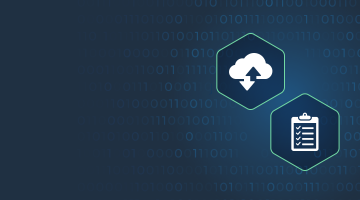

How to develop an effective data migration strategy
The early third millennium is the epoch of sweeping changes when nothing lasts for long. In the IT realm, the pace of transformations is even more rapid. So, technologies and approaches considered cutting-edge novelties just a couple of years ago swiftly become obsolete. They need to be replaced by innovations that are pushing the high-tech envelope.
This is true for data platforms as well: their satisfactory functioning is quite short-lived. After a while, it transpires that the on-premises system’s capabilities to handle enhanced workloads and data sources are inadequate. Augmenting it with new functionalities makes it unwieldy and too costly to maintain. Whatever revamping you do, it turns out to be only a band-aid unable to counter the gradual deterioration of the system’s technical condition. Every failure the legacy data platform experiences makes it clear that data migration is imminent.
Need to migrate data? Check out our data migration services.
What is data migration?
Data migration is the procedure of moving data from one data center (called a source system) to another (known as a target system). Besides, the same term is used to describe the data transfer process between data formats and applications. However, data migrations aren’t limited by the very process of information changing its data storage location. A comprehensive data migration plan also presupposes leveraging various data management solutions and techniques to perform data extraction, profiling, preparation, validation, and transformation. Finally, throughout the entire complex process, data quality is monitored across target systems.
Some ten years ago, such procedures involved acquiring pricey equipment and infrastructure, taking care of its security, training personnel, and updating software migration of today’s spells embracing the cloud. Today, cloud computing offers the most serviceable, flexible, and cost-effective way of storing and operating large amounts of data, aka enterprise data warehouse. Startups hydrate the cloud (as they call it) from inception. At the same time, older businesses have to engage the services of a data migration engineer and institute a data migration process to enjoy the benefits of the cloud.
Keep reading to learn how to do data migration appropriately.
Reasons behind cloud data migration
What makes organizations migrate information? Typically, data migration activities accompany a larger transformation the venture undergoes.
- Acquisition or merging. When several businesses unite, their databases have to be integrated to form a single environment that prevents data siloing and ensures comprehensive interoperability.
- Selling an enterprise segment. If there was a data depot in that department, it had to migrate elsewhere.
- The company’s expansion. The growth of the organization necessitates augmenting its data storage capacities.
- The company’s relocation. When you move to another city, region, or country, you will naturally want your database to travel with you.
- Software modernization. Replacing your legacy software with a new one is a good opportunity to rev up your data repository.
- Changes within the organization. Your management may have new ideas about the company’s structure, objectives, policies, and approaches. Radical transformations of this kind involve database migration steps.
- Adoption of an additional system. Sometimes, the existing system is enhanced with another one functioning on top of it. Both of them need to be adjusted in the databases.
- Aspiration for perfection. Realizing the inadequacy of outdated practices, CEOs can embark on a service improvement quest, making a data migration plan an essential summand of this process.
Realizing the necessity to transfer the historical data to a new system, storage, or format, the overwhelming majority of businesses today forsake the archaic on-premises data storage model and opt for cloud facilities.
You might be interested in creating a project plan for cloud migration.
If you want to follow in the wake of this disruptive trend, you should understand what type of migration your organization needs.
Types of data migration made plain
In fact, what is generally termed a data migration process covers several varieties of data transfer that may sometimes be part of a complex routine.
Storage migration
As the name suggests, it happens when data changes storage systems (usually located in different physical places). It may also include switching from paper to digital media, tapes to hard disk drives, or on-premises-based storage to a virtual one. Conventionally, businesses resort to it as they acquire new storage equipment or upgrade their current infrastructure.
Database migration
Databases are specialized data banks where information is preserved in a structured and organized format. Such data structures are managed via dedicated database software called Database Management System (DBMS). To migrate a database, data engineers move it from one DMBS to another or upgrade the existing database to enhance its capabilities. The latter process is much simpler, whereas switching over from an older DBMS to a newer one is quite challenging since such database migrations often involve the necessity of performing data integration of units with different data structures.
Application migration
It involves moving data between computing environments, typically occurring when a company changes its application software or app vendor. Here, the main difficulties are caused by disparate data models and formats utilized in the source and target infrastructures. Moreover, new apps’ interactions may differ significantly after the switch-over, which requires radically transforming data. To ensure data integrity and prevent data loss during and after the procedure, data migration specialists leverage high-end APIs and resort to writing mapping scripts.
Cloud migration
In fact, this is a storage migration of a kind, where on-premises data elements are transferred to the cloud or migrated data moves to another cloud service provider. The former is more frequent by far, with many organizations ditching their legacy data storages and embracing cloud computing environments.
Business process migration
Poised to enter new markets and hone their competitive edge, many enterprises transfer data concerning their business processes, metrics, and shop floor activities to a new environment. Such a data store usually covers customer, product, and operational records and dossiers.
Data center migration
A data center contains a comprehensive data storage infrastructure (servers, computers, network routers, and other equipment) responsible for maintaining a company’s vital applications. The essence of data center migration is moving these multiple systems to a new location or (more often) migrating data from the old infrastructure to the new one.
Depending on the migration type, you should opt for a suitable migration method.
How to migrate data from the legacy system to the cloud?
There are three basic data migration approaches to choose from.
The Big Bang method
Any data migration consultant will tell you that the migration process is rather stressful. If you opt for the big bang model, you will be able to keep stress and frustrations to a minimum. Why so? Because the Big Bang migration is completed within a stipulated period (typically during a weekend or official holiday). Such time windows are chosen since this approach requires the total downtime of the system while data is transferred to the new database. The old one has been taken out of operation for good.
Because of the short implementation period, the Big Bang migration is relatively quick and cheap, but it is subject to high risks of failure. But if performed by high-end data migration vendors, it can let your personnel start using the relocated database as soon as they come to the office on Monday, without the bother of synchronizing the employment of the old and the new system for some time.
The Phased method (Incremental)
Unlike the Big Bang strategy, this approach presupposes dividing the data in the source system into small, handy chunks. The latter are transferred to the target system module per module. Parallel functioning is limited to the increments in the process in transition, which is a great bandwidth-saving technique that ensures the unimpaired functioning of other system elements.
Naturally, this approach reduces risks and provides smooth migration but increases the time of transition and related expenditures. Moreover, for the phased migration, a carefully thought-out plan is a must since you should know the dependencies between modules to prevent shutting down the whole system while the migration is underway. Yet, an undeniable asset of this approach, favored in nigh on two-thirds of data migration projects, is that it gives users an opportunity to take novelties in their stride by small volumes, which spells less adaptation stress.
The Trickle method (Parallel)
Also known as the parallel run approach, this strategy involves the simultaneous functioning of two systems while data is being transferred from one platform to the other in real time. The major advantages of the trickle method are the absence of downtime and the opportunity to meticulously check how the new system operates. The latter is a kind of backup technique since you can always switch back (hopefully only temporarily) to the legacy database to eliminate issues within your new system in case they crop up.
This approach has its shortcomings, though. It is more complicated in preparation and implementation than the other two (and consequently more protracted) because the parallel functioning of the old and new systems requires significant synchronization efforts and close supervision of what has already been transferred and what is still waiting for its turn. Such complexity of tasks negatively affects the cost of the venture.
Which is the best way to migrate data? Being a seasoned player in the industry, we at DICEUS are sure that there is no one-size-fits-all approach. A plethora of factors is to be considered before you opt for this or that migration strategy.
For startups or small-size organizations with a modest amount of data and the possibility of taking a complete break-in operation, the Big Bang method works best. The phased technique works well for moderate-size databases that have close to no interdependencies. If you are a medium or large enterprise with a 24/7 lifecycle that can’t afford a total shutdown, the trickle approach would be the best choice.
Whatever strategy you eventually opt for, you should be aware of data migration challenges that lay in wait for you.
Data migration pitfalls to avoid

Having completed quite a number of data migration projects, DICEUS experts consider it essential to pay attention to the following issues when implementing data migrations.
Inadequate organization
Any serious undertaking demands a thorough preparatory stage, and data migration isn’t an exception. In case it is handled improperly, the whole endeavor is doomed to defeat. If you fail to compile a complete roster of files, identify their location, determine resources and tools, gauge the time of implementation, etc., the procedure is sure to go wrong very soon.
Solution. You can’t do without a detailed migration plan. The data migration checklist should include the project’s scope, goals, timeline, and specialists responsible for it.
Potential data loss
Anyone who has moved to a new place can tell a story about how they couldn’t find some item or another when they unpacked. The same happens with relocating data. The problem looks even more serious if the company misses the loss after a long while when this data (by Murphy’s law, it is sure to be some critical or sensitive information) is beyond recovery.
Solution. Make backups the rule of thumb. Don’t transfer any single piece of data without a copy. And make sure you know where this copy is.
Compatibility problems
Shifting to new software can sometimes result in the loss of files’ accessibility—you can’t read them anymore. In the worst case, the entire system may be rendered unusable, to the consternation of the stakeholders.
Solution. The data migration plan must include the operational requirements of both the old and the new systems. This will enable you to forestall possible compatibility issues and monitor the transition process to deal with possible problems. Only after you have made sure all files and applications work properly in the new environment can the legacy system be disabled.
Miscalculations in hardware limitations
You may underestimate the amount of data eligible for migration or overestimate the capacity of the target hardware, which will require urgent steps to ensure that the new equipment can accommodate all of your data.
Solution. You should carefully study the basic characteristics of the cloud facilities you are going to rent to make sure their capacity will suffice to host the data you plan to migrate.
Lack of collaboration
Typically, data migration is a team endeavor involving a bunch of people with their own responsibilities in the project. To make matters worse, this team may sometimes include both in-house and external actors participating from different locations. The disparity of purposes, responsibilities, and technologies is a huge impediment on the way to the successful completion of data transference. And if something goes wrong, people, as often as not, would resort to shifting the blame instead of trying to fix the problem.
Solution. Keep all migration team members on the same page through a platform and collaborative tools that help avoid misunderstandings.
Absence of testing
Your data migration methodology seemed to have worked well, but when you kick the new system into action, it’s a bummer. And you are at your wits’ end where the shoe pinches.
Solution. Running tests to explore all possible use case scenarios before and during the migration procedure is a sine qua non. So, you can detect problems at an early stage and nip them in the bud before they accrue to give you a headache.
When developing a data migration strategy, consider all of these fine points. The core of this strategy is a detailed data migration project plan.
Zooming in on the importance of a data migration strategy
A successful data migration is impossible without a well-thought-out strategy. This strategy is indispensable for obtaining a conceptual understanding and outlining a logical approach to moving source data to a new environment. First-rate data migration strategies articulate the required undertakings, streamline and facilitate the procedure, and establish the outcomes of the endeavor.
What are the must-have elements of an efficient data migration strategy?
- A data migration approach that suits your use case to a tee
- Clearly defined deliverables of the project
- A sensible migration timeframe with major milestones
- The roster of tools and resources necessary for accomplishing the project
- A detailed data migration plan
Since the latter is mission-critical for any serious effort, let’s find out more about it.
Developing a data migration plan: An algorithm to follow
An effective migration plan must include a series of data migration process steps.
Step 1. Analysis of objectives and business goals
You must clearly realize the reasons for migrating into the cloud and how your organization will benefit from it. Also, assess the time you can afford and the budget you are ready to allocate for the project.
Step 2. Mapping out the migration plan
Here you define the migration strategy, the scope of data, the tech stack (including data migration tools), the security measures to accompany the migration, the risk management policy, and the personnel that will tackle the task.
Step 3. Choosing a cloud provider
In accordance with the technical requirements, pricing policies, and other criteria, select the cloud service provider. If you opt for a public cloud, the odds are that you will choose one from the list of the most popular facilities offered by Google Cloud Platform, Microsoft Azure, Amazon Web Services, or IBM Cloud.
Step 4. Taking stock of both systems
By reviewing all pertinent documentation and available information, you should have a clear vision of the existing system’s operational requirements and realize how it can be aligned with the cloud environment you are going to move to.
Step 5. Preparing the data for migration
At this stage, you choose the order of components to transfer (paying close attention to interdependencies between them) and check whether they fit well with the cloud environment. If they aren’t cloud-friendly, the necessary refactoring should be undertaken.
Step 6. Ensuring backup
In case something goes wrong, you should have a backup of your current system to roll back at any stage of the migration procedure.
Step 7. Let the exodus commence
Start with some pilot data transfer to see how it works and test data operability in the new environment. Once the results meet expectations, proceed on a larger scale. Typically, the process follows the 5R sequence: rehost, refactor, revise, rebuild, replace. To facilitate the progress, you can use code bots that write code quicker than humans, thus enabling more iterations and granting a wider room for maneuver.
Step 8. Testing the new system
Nothing is over until you make sure the entire system works as expected. In case some issues arise, you have to deal with them as soon as possible.
As you see, there are slews of major difficulties and minute details to take care of, which make the migration a no-nonsense venture. The only way to ensure a smooth, fast, and secure process is to entrust it to an experienced company that can provide top-notch data migration services at a reasonable price.
DICEUS ticks all the boxes to successfully see through a data migration project of any complexity. During our 13 years of presence in the IT outsourcing market, we have implemented numerous data, cloud, enterprise system, and database migrations that have drastically improved our clients’ data handling workflows and allowed us to accumulate in-depth theoretical knowledge and hands-on skills in this niche. Also, we know this realm inside out to consult you on any related questions. To save you time, here are concise answers to some FAQs on data migration.
Data migration projects DICEUS has delivered
- Data warehouse for a bank. We undertook the creation of a data warehouse that should integrate a liquidity risk management system to cooperate with the European Bank for Reconstruction and Development. In a short time, we designed DWH architecture that embraced ETL processes for retrieving, modifying, and loading data from 15 sources and included a managerial reporting system. The developed solution was based on Oracle UBS FLEXCUBE, allowing it to analyze and control core banking operations and contained reporting tools for deposit and credit portfolios.
- Data aggregation hub for treasury. The customer’s requirement was the creation of a high-load secure web-based solution providing smooth data access, verification, validation, storage, and processing. We built a data hub that was capable of arranging data feeds from the existing databases (containing 1 mln + records) with subsequent matching against specific dictionaries. The delivered product has a user-friendly interface leveraging which employees can amend data manually if its values don’t match the reference sources.
- CRM data migration. A bank aimed to curtail churn rate, improve customer support, shorten time-to-market, and implement advanced analytics. All these goals were unachievable without migrating company data from the old Siebel CRM system to a modern Appian platform. Our experts identified how data was stored in the legacy system, devised data migration scripts, and performed the Big Bang migration first for a limited number of branches. Such an approach allowed us to fine-tune UX and later launch an improved solution for the entire branch network.
In general, during our 13 years of presence in the IT outsourcing market, we have implemented numerous data, cloud, enterprise system, and database migrations that have drastically improved our clients’ data handling workflows and allowed us to accumulate in-depth theoretical knowledge and hands-on skills in this niche. Also, we know this realm inside out to consult you on any related question. To save you time, here are concise answers to some FAQs on data migration.
FAQ
Why is data migration a necessity?
Old on-premises data repositories are increasingly falling behind the rapid pace of data accumulation and processing, so by hydrating the cloud, you can drastically improve the efficiency of your workflow.
What is data migration in ERP?
Implementing data migration in ERP has its peculiarities related to the integrated nature of this system, requirements for a single data source, the necessity of collaboration across multiple business domains, and the need for certain data modification.
What are data migration tools?
Data migration techniques and tools are special software that facilitates migration. The choice of the tool differs from case to case. Usually, it depends on the specifics of the project and the choice of the cloud provider. The most popular tools are AWS Data Migration, Azure DocumentDB, Apex Data Loader, Informix, DBConvert Studio, IRI NextForm, and Xplenty.
How much does data migration cost?
Data migration is never a bargain-price issue — on average, you should be ready to fork out a sum of around $250,000. Yet, there is no universal billing rate charged for a job of this kind. First of all, every project is unique. So, you have to consider a lot of factors that condition the end price. Secondly, the charges of data migration companies depend on their location. Vendors from Ukraine offer an excellent price/quality ratio of services. Contact us to get consulted on data migration strategies and best practices for free!
What is the difference between data migration and data transfer?
Data transfer is a much simpler process when data from one medium is moved to another via an internet connection or with the help of USB-based file relocation. It usually boils down to elementary copy/paste operations without any changes in data formats. Data migration goes beyond such data mapping and involves a range of preliminary data processing measures (cleaning, profiling, validation, backup, etc.), which are implemented to ensure seamless integration and further functioning of the migrated data in the new environment.
What should be included in a data migration strategy?
The core element around which a well-thought-out data migration strategy is devised is a detailed data migration plan. Other components of the strategy include a migration method (Big Bang, trickled, phased) that suits the use case, the indication of the project’s timeframe containing major milestones, the roster of migration tools to be utilized in the process, the list of specialists who will implement the project, and the deliverables you expect to obtain on accomplishing the project.





